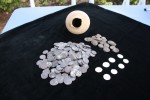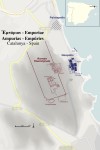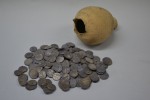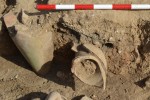 A team of archaeology students has unearthed a Republican-era Roman coin hoard at the Empúries site on the Costa Brava of Catalonia, northeastern Spain. The hoard was discovered secreted in a hole in the ground inside a 1st century B.C. domus. A small ceramic pot shaped like an amphora contained silver denarii from the same period as the home. This was a great deal of money in the 1st century B.C. when a soldier’s yearly pay was 225 denarii and two denarii would pay rent for a month. There is evidence of a fire destroying the property shortly thereafter, likely making the treasure irretrievable.
A team of archaeology students has unearthed a Republican-era Roman coin hoard at the Empúries site on the Costa Brava of Catalonia, northeastern Spain. The hoard was discovered secreted in a hole in the ground inside a 1st century B.C. domus. A small ceramic pot shaped like an amphora contained silver denarii from the same period as the home. This was a great deal of money in the 1st century B.C. when a soldier’s yearly pay was 225 denarii and two denarii would pay rent for a month. There is evidence of a fire destroying the property shortly thereafter, likely making the treasure irretrievable.
 The vessel still holding its hoard of coins was carefully excavated in a lab. Much to the archaeologists astonishment, the little amphora held 200 coins, the largest group of coins ever found in the Roman city of Empúries. They appear to be in good condition. Once the coins are cleaned and conserved, they will be identified and catalogued.
The vessel still holding its hoard of coins was carefully excavated in a lab. Much to the archaeologists astonishment, the little amphora held 200 coins, the largest group of coins ever found in the Roman city of Empúries. They appear to be in good condition. Once the coins are cleaned and conserved, they will be identified and catalogued.
The ancient city of Emporion was founded in the 6th century B.C. by Greek colonists from Phocaea in western Anatolia (modern-day Turkey). Its coastal location between Massalia (Marseille), also founded by Phocaeans, and the major trade center of Tartessos in southwestern Iberia, made Emporion a prosperous town. Its population boomed when the Phocaea was conquered by Cyrus II of Persia in 530 B.C. and refugees moved to the colony, making it the largest Greek settlement on the Iberian Peninsula.
 When much of the rest of Iberia was conquered by Rome, Emporion was allowed to remain independent, but the city backed the wrong horse during the civil wars of the 1st century B.C., and when Pompey was defeated by Caesar, Emporion was occupied by Roman legions. A new city, Emporiae, was built adjacent to the Greek town and populated by Roman veterans. The domus and insula are part of the Roman city.
When much of the rest of Iberia was conquered by Rome, Emporion was allowed to remain independent, but the city backed the wrong horse during the civil wars of the 1st century B.C., and when Pompey was defeated by Caesar, Emporion was occupied by Roman legions. A new city, Emporiae, was built adjacent to the Greek town and populated by Roman veterans. The domus and insula are part of the Roman city.
 The students are part of the Empúries Archaeology Course offered by the Archaeological Museum of Catalonia. It’s open to students working on an Archaeology or History degrees and graduate students, ideally with excavation experience. The program has been running every year without interruption since 1908. This year, the 30 students enrolled in the course have been excavating the tabernae (shops) and living spaces on the southern side of an insula (apartment building), with a particular focus on ceramics from the Late Republican period. The domus and its wine cellar occupied the southern side of Insula 30 in the earliest days of the Roman city. The room with the hoard was on the southwest side of the building.
The students are part of the Empúries Archaeology Course offered by the Archaeological Museum of Catalonia. It’s open to students working on an Archaeology or History degrees and graduate students, ideally with excavation experience. The program has been running every year without interruption since 1908. This year, the 30 students enrolled in the course have been excavating the tabernae (shops) and living spaces on the southern side of an insula (apartment building), with a particular focus on ceramics from the Late Republican period. The domus and its wine cellar occupied the southern side of Insula 30 in the earliest days of the Roman city. The room with the hoard was on the southwest side of the building.
 The pot in which the denarii were stashed puts the discovery of the hoard exactly on topic, plus a nice bonus of 200 silver coins. Even more on topic, the team also found 24 wine amphorae of Italian origin and a bronze simpulum, a long-handled ladle used to extract wine from the large vessels, in the wine cellar of the domus.
The pot in which the denarii were stashed puts the discovery of the hoard exactly on topic, plus a nice bonus of 200 silver coins. Even more on topic, the team also found 24 wine amphorae of Italian origin and a bronze simpulum, a long-handled ladle used to extract wine from the large vessels, in the wine cellar of the domus.